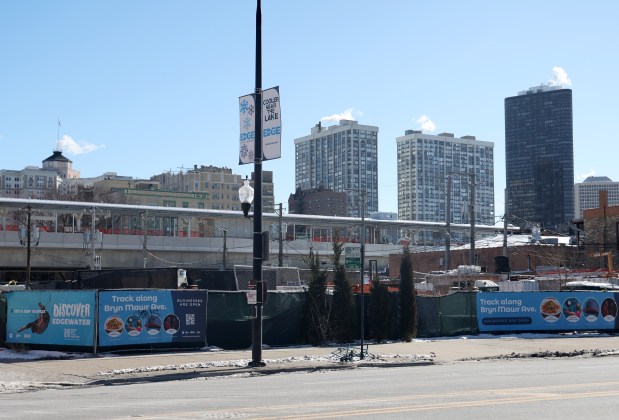Chicago’s plan to build “green social housing,” one of Mayor Brandon Johnson’s cornerstone housing initiatives, moved one step closer to being actionable Wednesday when Johnson introduced a key ordinance in the City Council meeting.
The city’s vision for green social housing is mixed-income rental buildings that are built to certain energy efficiency and decarbonization standards and in which at least 30% of the units are affordable. The city would own a majority stake in the buildings, a first-of-its-kind role for the city.
The ordinance, if passed, will establish the Residential Investment Corp., a nonprofit developer arm of Chicago’s Department of Housing that will have its own board — a mix of city staff and outside experts — and, eventually, its own executive director and other staff. The corporation will control a revolving loan fund that will offer low-cost, three- to five-year construction period loans to developers and be seeded with $135 million from the city’s $1.25 billion housing and economic development bond. The loan repayments will be recycled back into the fund for future housing projects.
“No other major big city has gotten to this point,” Department of Housing Commissioner Lissette Castañeda said in an interview with the Tribune. “We are transforming how we are developing affordable housing in the city of Chicago.”
The ordinance comes at a time when the city and country are grappling with how to address a severe shortage of affordable housing, as housing costs have skyrocketed in recent years and could potentially increase more with President Donald Trump’s recently imposed 25% tariffs on steel and aluminum. The mayor launched the $75 million “missing middle housing” initiative in October, an effort led by the Department of Planning and Development and also funded through the bond.
Additionally, in April, the mayor released his plan to “Cut the Tape” on development by easing rules and reviews, though little information has been shared on the plan. The U.S. Department of Housing and Urban Development’s newly appointed secretary, Scott Turner, has mentioned easing federal regulations to lower housing costs as well, according to the Wall Street Journal.
The ordinance already faces a roadblock as Ald. Gilbert Villegas, 36th, used a parliamentary maneuver to send it to the Rules Committee, a move that often delays the passage of legislation by requiring another vote. Asked why he made this move, Villegas said he introduced a different housing ordinance that would “create affordable housing units in months, not years.” He criticized the mayor for not taking his own proposal into account.
The low-cost loans proposed through the city’s green housing initiative will provide cheaper capital to developers for the traditionally most expensive financing piece for market rate construction, Castañeda said, covering about 15-30% of the total development costs per project. By offering cheaper capital to developers, she hopes the projects will be constructed faster. Developers will supply the rest of the funds needed to finance the projects.
For this mixed-income model to work, Castañeda said, the rents for the market-rate units have to be able to permanently subsidize the affordable units. Affordability levels will depend on the project and could change post-development based on the cash flow at the property. For now, the affordable units will target households making 50-80% of the area median income, or $56,050 to $89,700 for a family of four, according to the city. The city also expects the units to be more affordable given that utility costs will be lower due to the green building standards.
“With the city having control of this, the goal isn’t just to make money,” Castañeda said. “It’s actually to have a public good for people — housing as a public good and decommodifying it.”
Castañeda said she expects to hand out the $135 million to builders over the next three to five years and aims to have 400 units built annually, a “huge increase” to how many units the department is building now. She said the only other place in the country doing this type of work is Montgomery County, Maryland.
Developers whose housing projects have stalled due to financing issues may be able to apply for the funds, and the city will put out requests for proposals and/or qualifications to build on city-owned land. Castañeda declined to confirm specific sites earmarked for development.
If City Council approves the ordinance, Castañeda said the plan is to solicit developer participation in late summer or early fall and bring the first development proposal to City Council for approval in the first quarter of 2026. Shovels could be in the ground that same quarter, with the first properties coming online around 18 to 24 months later, the typical time it takes to construct apartment buildings.
The housing department’s nonprofit staff will not be in place when the first proposals are solicited, Castañeda said. Instead, existing department staff will pitch in, as well as outside consultants.
Once the apartments are built, the nonprofit corporation will select private property managers to operate the buildings.
Ald. Leni Manaa-Hoppenworth, 48th, said she is excited at the prospect of using an empty parcel of Chicago Transit Authority-owned land in her ward — located near the Red-Purple Line modernization project in Edgewater along Broadway — to build hundreds of green social housing units. Federal funding is currently not a reliable source of capital, she said, so this program will relieve Chicago from some of the burden of relying on federal dollars for housing construction.
“In this moment, we can take the reins and we can lead,” Manaa-Hoppenworth said in an interview. “Green social housing is going to be … the necessary means for us to progress forward for Broadway.”
ekane@chicagotribune.com
Chicago Tribune’s Jake Sheridan contributed.





